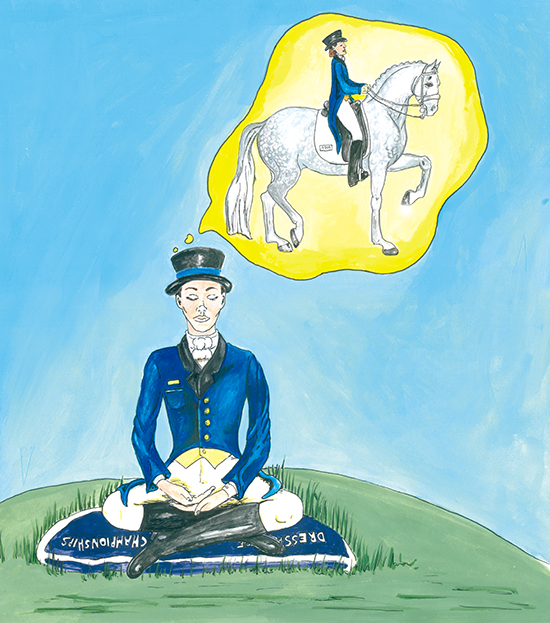 By Lisa Champion MSc (exercise science)
By Lisa Champion MSc (exercise science)
Last month we talked about stress management and how recognizing and addressing it in your life contributes to better well-being. In addition to changing the way you think about stress, it’s helpful to have some relaxation techniques up your sleeve. These techniques can be used before competitions, before you go to bed at night, when you wake in the middle of the night and can’t sleep, or when you are feeling overwhelmed with the pressures of your life. A good marker of when stress is getting the better of you is your breath. If you are breathing rapidly and shallowly, chances are you are feeling the pressures of a busy life and need to take a bit of time for relaxation.
In all three of the relaxation techniques that I’ll suggest, your breath plays a key role in helping the body and the mind rest. You can try these relaxation techniques when standing, sitting or lying down. You don’t necessarily have to be in a darkened room with soft music, although it does help if you are having trouble letting go. You could be a passenger in a horse truck on the way to a competition and take the time to do a seated relaxation exercise. You are only limited by your mind’s ability to pick a moment and then giving yourself permission to take a time out.
DEEP BREATHING
The first relaxation technique to try is slow, deep breathing. The busier you are the harder you will find this to do. You can try deep breathing anytime, anywhere. Start by taking a slow, deep breath in and think about expanding your rib cage as the breath sinks into your body. Then, breathe out slowly. Try breathing to the count of three. Breathe in – 2 – 3. Breathe out – 2 -3. Pause for a moment and repeat the cycle. It is helpful to breathe in and out through your nose, but if this feels uncomfortable, breathe however it feels easiest. When you first try to breathe more deeply, you may feel that it is really hard! Leon Chaitow, a world renowned expert on breathing, says that up to 60% of people suffer from breathing pattern disorders. In a nutshell, that means shallow, rapid breathing. And the busier and more stressed we are, the shallower and more rapidly we will breathe. So, working on deep breathing can be a first step towards better health. Start by doing 20-30 slow, deep breaths. If you are doing this just before you go to sleep at night, you may find that after only a few deep breaths, you nod off! You can also add a thought or a word to your deep breathing. Try saying to yourself the word ‘peace’ as you breathe in and ‘calm’ as you breathe out. Or choose any other word that has meaning to you and that elicits a relaxation response.
PROGRESSIVE MUSCLE RELAXATION
The second relaxation technique is called progressive muscle relaxation. The idea behind this technique is that by tensing and tightening all the muscles in your body, you will find areas that feel tight and will be better able to let them go. This technique is best done lying on your back with your legs straight out. Make sure the surface you are lying on is comfortable and that you are warm. Start by taking a few slow, deep breaths. Think of relaxing your whole body. Now, starting at your feet, begin to clench your toes. Then, move up the body, progressively clenching your calves, thighs, buttocks, abdomen, shoulders, arms, hands, and face until the whole body is being held rigid and tight. Hold for 5 seconds, clenching even tighter. Then, take a deep breath in and on the out breath, completely relax. Lie still and quiet, breathing deeply for a few moments before repeating the exercise. Repeat the tightening and relaxing 2-3 times and end with a few moments of slow, deep breathing. This technique is excellent for releasing the tension of the day just before you go to bed at night, but can be used at any time.
VISUAL IMAGERY
The final relaxation technique is called visual imagery. Again, start by lying on your back in a warm and comfortable place. Breathe slowly and deeply for a few moments before beginning to imagine yourself somewhere calm and peaceful. It may be floating on some beautiful, white clouds. It may be lying on a beach, in powdery, soft sand. Imagine that the sky is blue, that the water is crystal clear, that you can hear the sound of the waves nearby and that you are completely relaxed. Feel the warmth of the sun on your body and just lie there, enjoying the virtual place that you have created in your mind. It may be in a beautiful, grassy field of wildflowers, or lying in front of a roaring fire. As thoughts of the day enter your head, just let them pass through and turn your attention to your virtual place of peace and beauty. Slowly, you will sink into a deeper and calmer sense of rest. Stay there for as long as you can – enjoying the stillness, the beauty of the place you are imagining and the deepness of your breath.
While for some these techniques may seem a bit airy-fairy, they are sure to help you relax. So even if you covertly try them in the middle of the night, when your head is filled with the million things you have to do the next day, you will probably find they really help. If nothing else, take the time to breathe deeply. Not only will your body and mind feel better for it, your horse will probably appreciate it as well!
Illustration by: Andrea O’Meara
